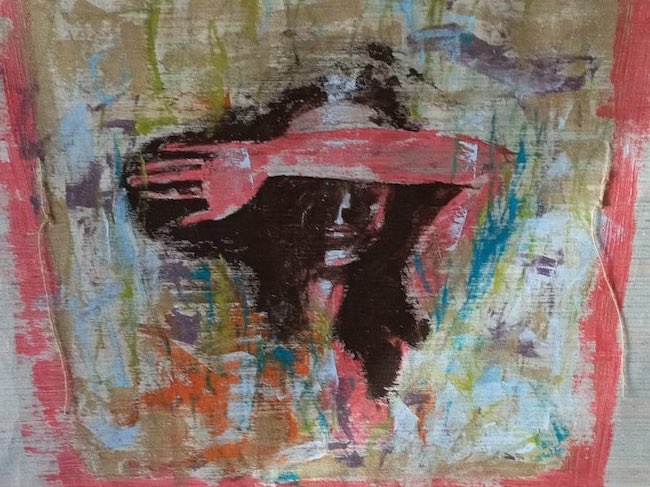La necessità di andare oltre per immergersi all’interno di tutto ciò che non appare a un primo sguardo, contraddistingue il percorso creativo degli artisti, che divengono così ascoltatori e di conseguenza interpreti di un approfondimento che l’uomo contemporaneo non sembra essere capace di compiere in maniera autonoma. Ecco dunque che il linguaggio pittorico ha bisogno di distaccarsi dalla perfezione visiva, ormai appartenente al mondo virtuale, a quello delle immagini fotografiche oggi alla portata di tutti, per introdurre e consolidare l’importanza di allontanarsi dall’estetica superficiale e votata solo all’apparenza, anche a costo di stravolgere l’aspetto dell’osservato pur di lasciar emergere tutto quel mondo emotivo e intenso che costituisce in fondo la vera essenza del tutto. La protagonista di oggi svela attraverso le sue opere un’inclinazione all’indagine su un’interiorità che non può essere ignorata, piuttosto esaltata nella sua imperfezione, e all’ascolto di tutte quelle energie impercettibili che pure esistono e si svelano solo a chi sa interpretarne la forza.
Quando tra la fine del Diciannovesimo e gli inizi del Ventesimo secolo fu evidente quanto la pura estetica non fosse più al passo con i tempi perché la bellezza, se privata di tutto ciò che apparteneva al mondo del sentire e alla soggettività dell’artista, era fine a se stessa e non più in grado di suscitare quell’ammirazione che nei confronti dell’arte si era avuta fino a poco prima, cominciarono a delinearsi movimenti tendenti a mettere in risalto tutto ciò che sembrava a sfuggire allo sguardo perché nascosto dalla realtà osservabile. Mentre dunque il Simbolismo scrutava e rappresentava il rapporto tra uomo e natura, tra tutto ciò che era quasi inspiegabile e misterioso e l’essere umano che rimaneva inconsapevole di tutto quel mormorare e muoversi di oggetti ed elementi apparentemente inanimati, raccontando metafore e allegorie incomprensibili ai più, l’Espressionismo al contrario si propose di semplificare i messaggi, rinunciando a qualsiasi equilibrio formale per dare spazio prioritario a tutte quelle tempeste emozionali che contraddistinguevano gli artisti degli inizi del Novecento, ribelli proprio perché consapevoli di poter riscrivere la storia dell’arte in virtù delle innovative idee e regole cromatiche e stilistiche in cui venivano stravolti tutti i parametri precedenti. Dai colori accesi e violenti dei Fauves, accompagnati da una completa mancanza di profondità, prospettiva, equilibrio estetico, si passò ben presto all’Espressionismo in cui la gamma cromatica venne attenuata pur mantenendo la medesima necessità di assecondarsi al sentire dell’esecutore dell’opera; Edvard Munch, Egon Schiele, Emil Nolde, artisti diversi tra loro per stile e per interpretazione della corrente pittorica, eppure ciascuno di essi in grado di imprimere sulle tele quel mondo interiore troppo atterrito, spaventato dagli eventi che si susseguivano nell’Europa di inizio secolo, dalle devastazioni della guerra, dalla necessità di aggrapparsi a valori meno effimeri di quelli inseguiti dalle nuove regole della società e dalla classe borghese emergente. L’eredità di questi maestri fu raccolta e riattualizzata dai grandi esponenti della Scuola di Londra, in particolare da Lucian Freud e da Francis Bacon i quali ognuno a proprio modo sottolinearono attraverso la deformità nelle forme dei loro personaggi, l’esigenza di andare oltre l’apparire per spingersi nel significato, nel vissuto più vero, nella sostanza completamente divergente da quella forma che non poteva costituire la base imprescindibile dell’esistenza.
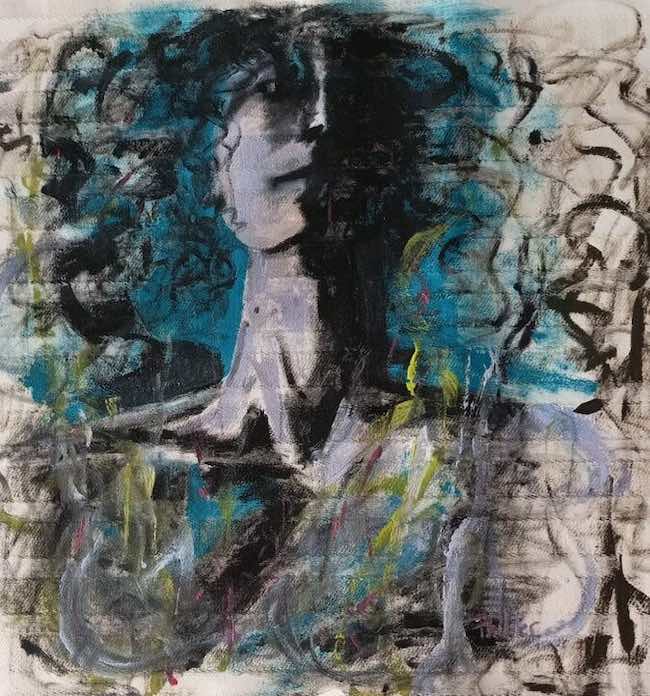
L’artista calabrese Erminia Fioti, in arte Phil Tes, compie il medesimo percorso di approfondimento, aggiungendovi una riflessione su tutto ciò che appartiene al mondo sussurrato delle sensazioni che riescono a emergere solo grazie alla sua sensibilità, permettendole di interiorizzare e poi liberare ciò che accade intorno a lei per poi posporlo sulla tela, come se la sua voce pittorica divenisse interprete di quei frammenti di vita e di emozioni che hanno scolpito nella sua memoria l’immagine poi raccontata. Con una tale attitudine all’esplorazione dei motivi più celati di ciò che inevitabilmente appartiene alla realtà degli accadimenti e delle circostanze, Erminia Fioti non poteva non scegliere l’Espressionismo che in alcune opere vira verso l’Astrattismo, quasi come se i confini già imperfetti e appena accennati dei personaggi narrati fossero troppo limitanti per il fluire di un mondo emotivo che ha bisogno dell’indefinitezza per potersi esprimere nella sua pienezza.
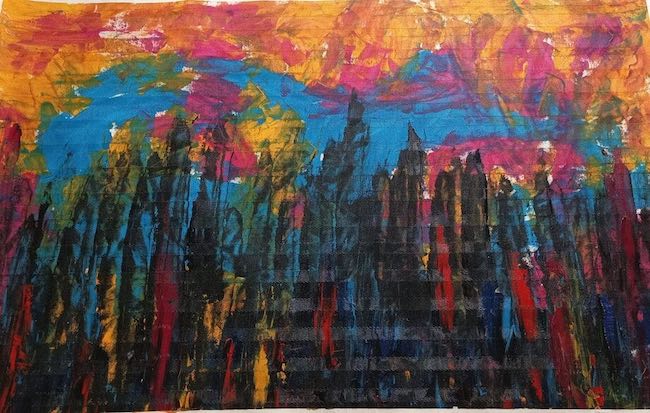
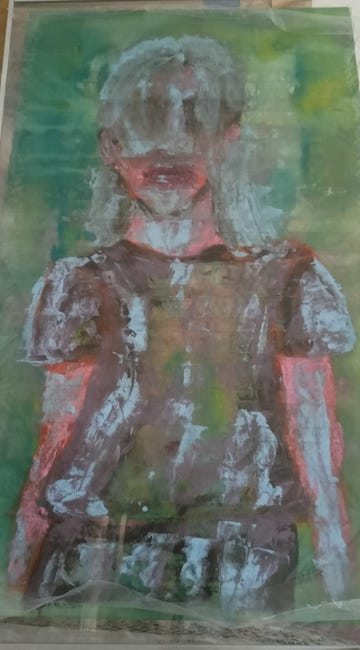
L’interiorizzazione di ciò che viene assorbito dalla sua sensibilità si traduce spesso in forme appena accennate, come se una rappresentazione troppo fedele all’osservato potesse essere un ostacolo a un mettersi a nudo fondamentale per l’istinto comunicativo delicato e al tempo stesso forte che ha bisogno di fuoriuscire; non solo, Erminia Fioti lascia che i suoi soggetti, in prevalenza donne, escano timidamente dall’ombra del silenzio lasciando delicatamente la loro traccia, rimanendo defilate, confuse dentro sfondi che da un lato sembrano trattenerle mentre dall’altro le spingono verso l’esterno, come se cercassero un canale comunicativo di quelle voci che al di fuori dell’espressione artistica non troverebbero il coraggio di farsi sentire. L’artista affida alle sue donne la materializzazione di una sensazione percepita, di un pensiero che ha attraversato la mente quando ha osservato un preciso frammento di vita e che poi ha interpretato pescando dentro il proprio mondo interiore con empatia ma soprattutto con una notevole capacità interpretativa nei confronti dell’essere umano e della natura che inevitabilmente si accorda al suo sentire.
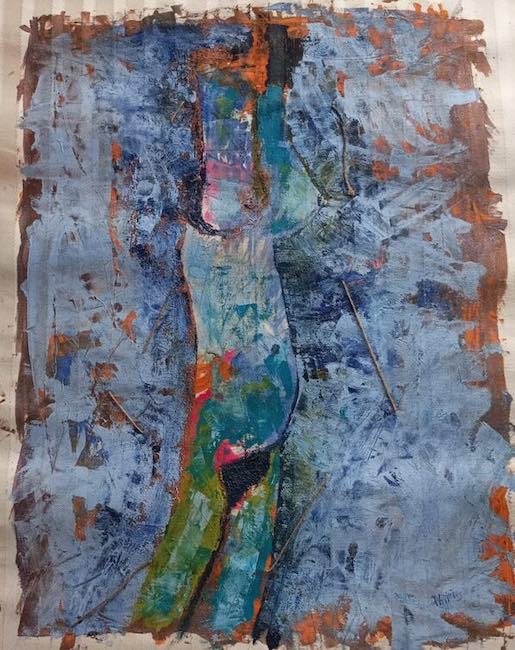
La tela Arrivò nel bosco, sparì nel bosco sembra raccontare una nuova Eva, una donna che ha bisogno di mettersi a nudo, metafora della figura femminile in una società contemporanea dove le viene richiesto di essere forte, pragmatica, assumendo caratteristiche quasi maschili per poter competere nel mondo professionale e per difendere e proteggere le proprie fragilità in quello personale; questo è il motivo per cui la donna, in realtà una visione, viene raccontata nella sua nudità nascosta però dallo sfondo, quasi confusa dentro l’ambiente che la circonda perché il suo è solo un attimo di introspezione, quell’istante di cui la vera essenza necessita per ricordarsi di come è davvero prima di rientrare nel bosco della quotidianità e dell’apparenza che costituiscono un’armatura protettiva nei confronti del mondo. Il bosco in realtà ha i colori onirici, l’azzurro polvere, a sottolineare quanto la dimensione in cui Erminia Fioti colloca quel corpo sia legata all’universo profondo e segreto dell’interiorità.
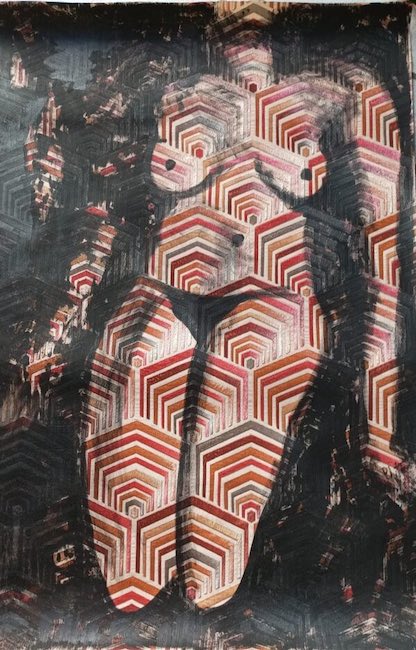
Anche in Ignoramus et ignorabimus n. 3 è protagonista il corpo nudo femminile, come se quello del nascondersi e mostrarsi solo nell’intimità della propria fase solitaria e introspettiva fosse un augurio, un mantra da ripetere persino a se stessa per non dimenticarsi di mantenere il contatto con la parte più pura e spontanea, quella che spesso viene ignorata proprio per la mancanza di approfondimento della società contemporanea, troppo frettolosa e superficiale per soffermarsi a osservare con maggiore attenzione le persone accanto a sé. Qui il tratto è più figurativo e la donna è nascosta da motivi geometrici evidenziando così la predominanza della ragione sul cuore, del pragmatismo su quell’universo emozionale che apparterrebbe alla donna in particolare, e all’essere umano in generale, se fosse capace di conservare e coltivare quella profonda sostanza di cui è fatta l’anima.
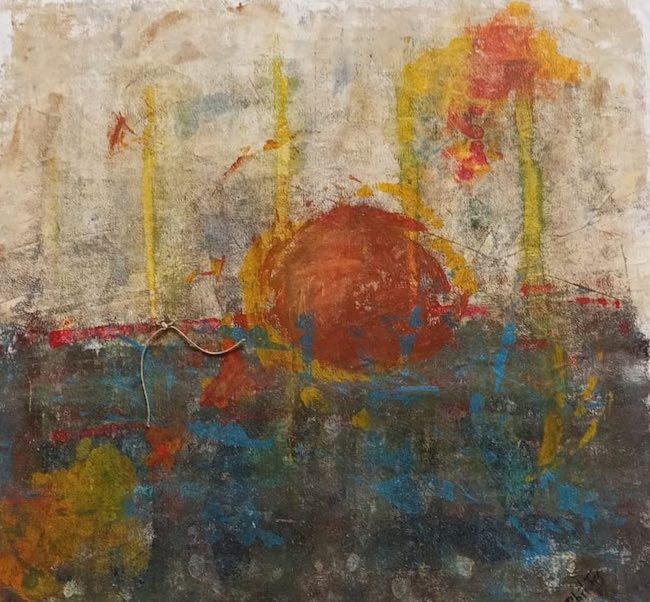
Nei paesaggi invece la figurazione lascia spazio alla suggestione del silenzio, all’atmosfera che ha colpito l’attenzione di Erminia Fioti nel momento in cui si è trovata davanti agli scorci che poi non può fare a meno di narrare, perché in fondo l’energia esterna è entrata in contatto con la sua capacità di ascolto permettendole di lasciarsi trasportare da quell’attimo irripetibile che poi si è immortalato sulla tela; l’opera La natura delle ragioni esprime perfettamente questo concetto di connessione tra la sensibilità dell’artista e l’ambiente in cui si trova a lasciar vagare il suo sguardo, fra trasporto emozionale e capacità di osservare la bellezza di ciò che è davanti al suo sguardo, pur scegliendo ancora una volta un tratto espressionista perché per lei usare i colori come fossero parole è necessità irrinunciabile. E dunque le ragioni si dissolvono e si fanno da parte davanti alla bellezza mozzafiato della natura che la sensibilità traduce in emozione visiva.
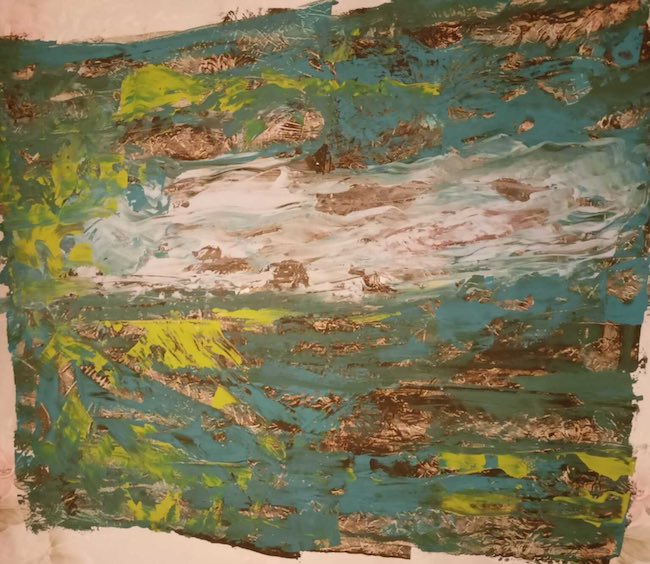
La carta da parati è il supporto su cui Erminia Fioti preferisce operare, quasi come se la ruvidità e rigidità di quel tipo di tela le fosse necessario a scolpire più efficacemente il vortice di sensazioni che costantemente riceve. Erminia Fioti, oltre che artista anche talentuosa fotografa e poetessa, ha al suo attivo la partecipazione a molte mostre collettive e personali in Italia e all’estero – Portogallo -, ed è rappresentata dalla gallerista Giovanna Adamo.
ERMINIA FIOTI-CONTATTI
Email: philtes@hotmail.it
Sito web: https://erminiafiotiarte.jimdofree.com/
Facebook: https://www.facebook.com/erminia.fioti
Impressions and reflections on the implications of life in Expressionism by Erminia Fioti
The need to go beyond in order to immerse oneself in everything that does not appear at first glance, characterises the creative path of artists, who thus become listeners and consequently interpreters of a deepening that contemporary man does not seem to be able to do independently. Here, then, the language of painting needs to detach itself from visual perfection, now belonging to the virtual world, that of photographic images today affordable for everyone, in order to introduce and consolidate the importance of moving away from superficial aesthetics devoted only to appearance, even at the cost of distorting the look of the observed in order to allow all that emotional and intense world to emerge, which constitutes, after all, the true essence of everything. Today’s protagonist reveals through her artworks an inclination to investigate an interiority that cannot be ignored, but rather exalted in its imperfection, and to listen to all those imperceptible energies that nevertheless exist and are only revealed to those who know how to interpret their strength.
When, between the end of the 19th and the beginning of the 20th century, it became clear that pure aesthetics were no longer in step with the times because beauty, if deprived of everything that belonged to the world of feeling and the subjectivity of the artist, was an end in itself and no longer capable of arousing the admiration that had been felt for art until recently, began to emerge movements that tended to highlight everything that seemed to escape the gaze because it was hidden by observable reality. While Symbolism therefore scrutinised and represented the relationship between man and nature, between all that was almost inexplicable and mysterious and the human being who remained unaware of all that murmuring and moving of apparently inanimate objects and elements, telling metaphors and allegories incomprehensible to the most, Expressionism on the contrary set out to simplify messages, renouncing any formal balance in order to give priority space to all those emotional storms that characterised the artists of the early 20th century, rebels precisely because they were aware that they could rewrite the history of art by virtue of the innovative ideas and chromatic and stylistic rules in which all previous parameters were overturned. From the bright, violent colours of the Fauves, accompanied by a complete lack of depth, perspective and aesthetic balance, we soon moved on to Expressionism in which the chromatic range was toned down while maintaining the same need to go along with the feelings of the artwork’s executor; Edvard Munch, Egon Schiele, Emil Nolde, artists who differed from each other in style and in their interpretation of the pictorial current, yet each of them was able to imprint on canvas that inner world that was too terrified, frightened by the events that were taking place in Europe at the beginning of the century, by the devastation of the war, by the need to cling to less ephemeral values than those pursued by the new rules of society and by the emerging bourgeois class.
The inheritance of these masters was picked up and re-actualised by the great exponents of the School of London, in particular by Lucian Freud and Francis Bacon, who each in their own way emphasised through the deformity in the look of their characters, the need to go beyond appearance to push into meaning, into the truest experience, into the substance completely diverging from that form which could not constitute the indispensable basis of existence. Calabrian artist Erminia Fioti, in art Phil Tes, follows the same in-depth path, adding to it a reflection on everything that belongs to the whispered world of sensations that only manage to emerge thanks to her sensitivity, allowing her to internalise and then release what happens around her and then place it on the canvas, as if her pictorial voice became the interpreter of those fragments of life and emotions that have sculpted in her memory the image then recounted. With such an aptitude for exploring the most hidden motifs of what inevitably belongs to the reality of events and circumstances, Erminia Fioti could not fail to choose Expressionism, which in some works veers towards Abstractionism, almost as if the already imperfect and barely hinted at boundaries of the narrated characters were too limiting for the flow of an emotional world that needs indefiniteness in order to express itself in its fullness. The internalisation of what is absorbed by her sensitivity is often translated into barely hinted at forms, as if a representation that is too faithful to the observed could be an obstacle to a fundamental laying bare of oneself for the delicate yet strong communicative instinct that needs to escape; not only this, Erminia Fioti lets her subjects, mainly women, shyly emerge from the shadows of silence, delicately leaving their trace, remaining out of sight, confused within backgrounds that on the one hand seem to hold them back while on the other push them outwards, as if seeking a communication channel for those voices that outside of artistic expression would not find the courage to make themselves heard. The artist entrusts her women with the materialisation of a perceived sensation, of a thought that crossed her mind when she observed a precise fragment of life and that she then interpreted by fishing within her own inner world with empathy but above all with a remarkable interpretative capacity towards the human being and nature that inevitably accords with her feeling.
The canvas She arrived in the woods, disappeared into the woods seems to tell the story of a new Eve, a woman who needs to lay herself bare, a metaphor of the female figure in a contemporary society where she is required to be strong, pragmatic, taking on almost masculine characteristics in order to compete in the professional world and to defend and protect her own fragility in the personal one; this is why the woman, actually a vision, is portrayed in her nakedness hidden, however, from the background, almost confused within her surroundings because hers is only a moment of introspection, that instant that the true essence needs to remind itself of how it really is before re-entering the woods of everyday life and appearances that constitute a protective armour against the world. The forest actually has dreamlike colours, powder blue, underlining how much the dimension in which Erminia Fioti places that body is linked to the profound and secret universe of interiority. Also in Ignoramus et ignorabimus no. 3, the naked female body is the protagonist, as if that of hiding and showing oneself only in the intimacy of one’s own solitary and introspective phase were a wish, a mantra to be repeated even to oneself so as not to forget to keep in touch with one’s purest and most spontaneous side, the one that is often ignored precisely because of contemporary society’s lack of in-depth study, too hasty and superficial to pause and observe more carefully the people around one’s side. Here the stroke is more figurative and the woman is hidden by geometric motifs, thus emphasising the predominance of reason over the heart, of pragmatism over the emotional universe that would belong to women in particular, and to human beings in general, if they were capable of preserving and cultivating that deep substance of which the soul is made. In the landscapes, on the other hand, figuration gives way to the suggestion of silence, to the atmosphere that caught Erminia Fioti‘s attention the moment she found herself in front of the views that she could not help but narrate, because after all, the external energy came into contact with her ability to listen, allowing her to let herself be transported by that unrepeatable moment that was then immortalised on canvas; the artwork The Nature of Reasons perfectly expresses this concept of connection between the artist’s sensitivity and the environment in which she lets her gaze wander, between emotional transport and the ability to observe the beauty of what is before her gaze, although once again she chooses an expressionist trait because for her, using colours as if they were words is an indispensable necessity. And so reasons dissolve and step aside before the breathtaking beauty of nature that sensitivity translates into visual emotion. Wallpaper is the medium on which Erminia Fioti prefers to work, almost as if the roughness and rigidity of that type of canvas were necessary for her to more effectively sculpt the vortex of sensations that she constantly receives. Erminia Fioti, not only an artist but also a talented photographer and poet, has participated in many group and solo exhibitions in Italy and abroad – Portugal – and is represented by gallery owner Giovanna Adamo.


